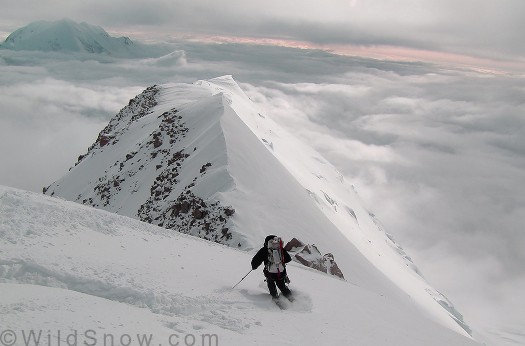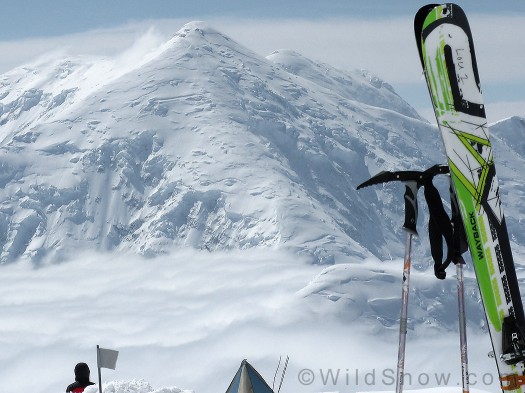
Lou skiing Washburn Ridge at about 16,500 feet, Denali, on his Waybacks. Perfect skis for these conditions. Click image for a mouth watering enlargement.
Louie and I had our pick of the K2 litter for our Denali planks. While having a big ski on the Big Mac can be nice for those few days you actually can enjoy going downhill with some beef on the hoof, you have to face the reality that most of Alaska Range ski mountaineering involves going up. Or, when you do ski downhill, the best (or at least safest) style is frequently a slow and intricate dance over and around crevasses, blue ice sheets, sastrugi, other people’s ropes, fixed ropes, rocks, frozen ski tracks, avalanche debris and who knows what else. You get the picture.
Hence, Louie and I figured our best choice for Denali skis would be something super light and somewhat short, but which could still handle variable conditions without requiring a lot of power for steering input. Fortunately I’d been playing around with the K2 Baker SL (superlight) for some time, and knew that ski was well suited for what our ski mountaineering style would be on the big one (doesn’t involve high speed power ). As most of you know, K2 recently revamped their whole line of backcountry oriented skis, renamed the line as “Backside.” They renamed the models, then began tweaking. The Baker SL became the Wayback, which this year will evolve to a nicely rockered board that skis great, is incredibly light, and as I now know is plenty durable.

Commodious tip rocker is now a marquee of every K2 ski made.
Construction of the Wayback is not much different than past iterations. The core is a lightweight sheaf of paulownia, aspen and bamboo, wrapped with just the right amount of fiberglass. Plenty of carbon fiber is used in the build as well, hence a ski this light (51.5 oz, 167 cm) — lack of mass that’s right up there in the ruling class of the ski weight population (see our ski weights).
Waybacks look nice too, with a bold but still restrained abstract pattern of greens and blacks. But just like ski town girlfriends (or boyfriends), who cares how they look as long as they can ski.
In this case, yes, she can.
From what I understand, if you use now classic fat ski dimensions and play around a bit with construction and introduce some tip rocker, it is not that tough to build a ski that rides well. People even do it in their garages. But play in the realm of 88 mm waists and sub 60 ounce weights and you’re in a different game.
Thus, one has to admire the fine tuning that obviously went into the Wayback. First, the 20 meter sidecut combined with tip rocker makes this easy and fun in powder, as well as more forgiving in breakable than I expected my short 167s to be. Nontheless, due to the tip rocker they ski short, so for Colorado or Wasatch powder laps my 167s might be too stubby for my weight (155 lbs more or less). Even on Denali I found myself sometimes wanting a longer length such as the 174 cm version Louie used up there, if for no other reason than I could have relaxed a bit and saved my leg strength in places such as the ski hill above 14,200 feet. That said, I’d still bring the 167s for any sort of ski alpinism that involved steeper, more intricate terrain (for example, I used the little sticks to great effect on the Washburn Ridge). Also, let’s not forget a shorter lighter ski is a joy on the climb as they really are quite nimble and ‘way’ easy on the up.
If you’re a true ski alpinist, you’ll end up on steep icy descents once in a while. Such situations can be more dangerous than you sometimes think, as one slip can send you down so fast you have no chance of self arresting, Whippets or not. We were in that situation during our Mount Hood descent a few weeks ago. Wayback isn’t exactly designed for long pitches of 40 degree steep white ice, and rocker most certainly doesn’t help in those situations. But they got me down and did better than I expected. (Key with using a ski such as this on hard snow is to keep your edges tuned as you don’t have as much leeway in terms of what the ski can do with dull edges.)
Above being said, if you make a habit of skiing steep hard snow you would definitely want a plank that was better on hardpan. In the case of K2 Backside line, Coomback and Backlash are good examples of versatile skis that do soft snow as well as harder, with more power than a superlight plank such as Wayback.
So there you go, I’d recommend Wayback as a forgiving soft-snow and variable conditions plank that is super efficient for the uphill. They’ll continue to be my ski of choice for spring ski mountaineering, and if I had to leave for Denali tomorrow, I’d sharpen those edges and bring them again. Louie seconds that emotion about his 174s , only he says “I loved ’em.” So that’s a Wildsnow four thumbs up.
WildSnow.com publisher emeritus and founder Lou (Louis Dawson) has a 50+ years career in climbing, backcountry skiing and ski mountaineering. He was the first person in history to ski down all 54 Colorado 14,000-foot peaks, has authored numerous books about about backcountry skiing, and has skied from the summit of Denali in Alaska, North America’s highest mountain.

